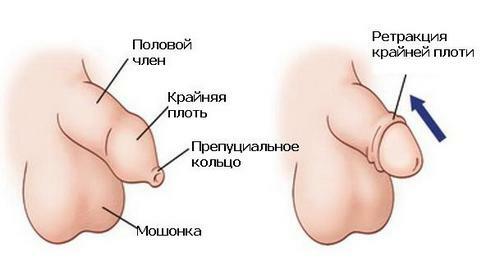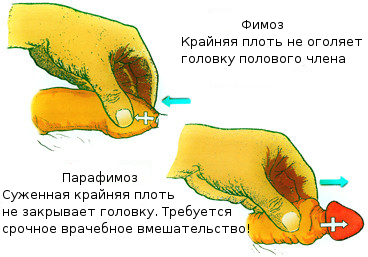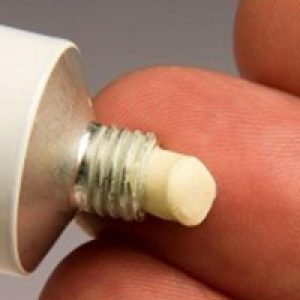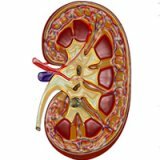Phimosis: symptoms, causes, treatment
 The normal anatomical structure of the penis is such that the skin covering it forms a crease in the head region.This fold, called "foreskin", descends on the head and partially or completely covers it, but it can easily be moved upwards.The slit circular space between the thin skin of the head and the foreskin is called the prepuce cavity( the prepuce sack).It accumulates smegma - the secret of many small glands located in the skin of the head of the penis.
The normal anatomical structure of the penis is such that the skin covering it forms a crease in the head region.This fold, called "foreskin", descends on the head and partially or completely covers it, but it can easily be moved upwards.The slit circular space between the thin skin of the head and the foreskin is called the prepuce cavity( the prepuce sack).It accumulates smegma - the secret of many small glands located in the skin of the head of the penis.
The condition in which the foreskin is narrowed, and complete exposure of the head is impossible, is called phimosis.
Table of contents: Physiological phimosis in boys Hygiene of boys with physiological phimosis Classification of phimosis Causes of phimosis What can complicate phimosis?Phimosis in adult men Treatment of phimosis: medicamentous methods Operation in phimosisPhysiological phimosis in boys
According to statistics, 96 of 100 born boys may notice that their son's penile head is not exposed completely or partially exposed when shears the foreskin.A pediatrician or a pediatric surgeon will certainly diagnose a phimosis with a boy.But this phimosis is considered
physiological , because it is caused by age-related anatomical and physiological features. 
Sometimes, between the scalp and the inner leaf of the foreskin, tender embryonic adhesions( synechiae) are retained, making it difficult to remove the head.As the penis grows, it gradually spreads the preputial sack, and by 6-7 years( sometimes earlier) its excretion becomes free. Note: if the child does not care, then such a phimosis does not require treatment, but supervision.
Phimosis is a variant of the norm or is it still a pathology? You will find out the expert's opinion after watching this video review:
Hygiene of boys with physiological phimosis
 Parents of boys with physiological phimosis should pay special attention to the careful daily( at least twice a day) toilet of the vulva and perineum of the child.But during the erosion, in no case should forcibly remove the foreskin for the head of the penis.
Parents of boys with physiological phimosis should pay special attention to the careful daily( at least twice a day) toilet of the vulva and perineum of the child.But during the erosion, in no case should forcibly remove the foreskin for the head of the penis.
First, if the foreskin is still welded to the head of the synechiae, it threatens the formation of erosion on the inner surface of the preputial cavity, the development of inflammation and, as a consequence, secondary phimosis.Secondly, the forced removal of the head can lead to its infringement of the narrowed preputial ring - paraphimosis.And it requires urgent intervention of the surgeon to prevent the development of edema of the head of the penis with subsequent necrosis due to a violation of its blood supply.In the early stages of paraphimosis, the physician corrects the head under anesthesia, while in the later stages it dissects the infringing ring and cuts off the foreskin.
Neglect of simple hygienic procedures is a direct way to the development of balanoposthitis( inflammation of the glans penis and foreskin), since the accumulation of smegma in the preputial cavity serves as a favorable medium for the reproduction of bacteria.
Classification of phimosis
- Phimosis can be atrophic and hypertrophic .In the first case, the weaned foreskin tightly surrounds the head and has a pinhole with hardened edges.In the second - excessively developed foreskin hangs from the head, resembling a proboscis.In both cases, the prepuce sack becomes almost a closed space.
- By the nature of the occurrence the disease can be congenital and acquired .The diagnosis of congenital phimosis is given to boys 12-13 years old with physiological phimosis, in which the head never fully opened when the foreskin is shifted.In this situation, one should not immediately "run" to the operation.But to visit a pediatric surgeon, who will take the child under observation and subsequently determine the therapeutic tactics, it is necessary.
- Four degrees of phimosis are distinguished by severity, each with its own clinical picture:
- is a phimosis of the 1st degree, when during the erection the head of the penis opens with difficulty, and in a relaxed state it is free.Often an erection is accompanied by painful sensations;
- is a phimosis of the second degree, in which exposing the head at rest requires a certain effort, and in the excited state it is impossible.The pain accompanies every attempt to bring the head out;
- phimosis of the third degree, when the head does not open either at rest or with an erection;
- is a phimosis of the fourth degree, in which the symptoms of urinary incontinence are added to the symptoms listed above.Normal outflow of urine is impossible, the child strains during urination, worries.The foreskin is swollen due to the filling of the prepuce bag of urine, but outwardly it flows out with drops or a thin trickle.Stagnation of urine promotes the multiplication of pathogenic microorganisms and the development of inflammation.
In case of phimosis of III and IV degree, painful sensations go to the background.
The pediatrician tells the following about the features of diagnosis and treatment of phimosis in boys:
Causes of phimosis
The reasons for the development of acquired phimosis in previously healthy boys( men) and the factors contributing to it are:
- non-observance of the rules of personal hygiene, giving rise to inflammatory processes;
- due to the genetic inconsistency of connective tissue, manifested by a decrease in its elasticity and, as a result, the formation of micro-snapping of the foreskin during its extension;
- inflammatory diseases of the foreskin and glans penis, accompanied by accumulation of exudate and the appearance of microcracks;
- traumatic damages to the penis;
- scleroderma of the penis.
Skin defects that appear in all pathological conditions listed above, heal with the formation of scars, which further reduce the elasticity of the foreskin and approximate the development of acquired phimosis.That is why the most common form of this disease is cicatricial phimosis, which necessarily requires treatment.
Is it necessary to treat phimosis in a child?The expert answers:
Than phimosis can become complicated?
Among the complications of phimosis the most frequent are:
- paraphimosis, the development of which boys are often provoked by masturbation;
- balanitis or balanoposthitis, accompanied by redness, pain, itching in the head of the penis, purulent discharge from the foreskin;
- ascending infection( urethritis, cystitis, pyelonephritis) due to impairment of outflow and stagnation of urine;
- fusion of the foreskin with the glans penis due to their close fit to each other.
 You do not need to be an expert to track and understand that vicious circle into which a sick phimosis enters.Diseases and pathological conditions that provoked the formation of acquired phimosis, under certain conditions, sooner or later become its complications and again contribute to the progression of the disease and worsening of the patient's condition.In a similar closed circle, the patient rotates with a once-complicated congenital phimosis.Infinitely this can not continue, therefore, if the doctor insists on treatment, you should not refuse.
You do not need to be an expert to track and understand that vicious circle into which a sick phimosis enters.Diseases and pathological conditions that provoked the formation of acquired phimosis, under certain conditions, sooner or later become its complications and again contribute to the progression of the disease and worsening of the patient's condition.In a similar closed circle, the patient rotates with a once-complicated congenital phimosis.Infinitely this can not continue, therefore, if the doctor insists on treatment, you should not refuse.
About complications in phimosis, Dr. Komarovsky tells:
Phimosis in adult men
 Timely unrecognized or untreated phimosis in the boy will become its far from the best "companion" in adulthood.Phimosis in adult men is manifested by discomfort during coition, lack of satisfaction from sex, pain in the penis during urination.Sometimes the disease becomes a serious obstacle to sexual activity.The risk of complications is extremely high: balanoposthitis, paraphimosis, etc. Important : Phimosis in men is considered to be a factor in the development of penile cancer.
Timely unrecognized or untreated phimosis in the boy will become its far from the best "companion" in adulthood.Phimosis in adult men is manifested by discomfort during coition, lack of satisfaction from sex, pain in the penis during urination.Sometimes the disease becomes a serious obstacle to sexual activity.The risk of complications is extremely high: balanoposthitis, paraphimosis, etc. Important : Phimosis in men is considered to be a factor in the development of penile cancer.
Treatment of phimosis: medical methods
 Conservative treatment of phimosis involves the external use of hormonal( corticosteroid) ointments or decoctions of medicinal herbs( in the form of trays of them) in combination with stretching with the fingers of the foreskin.
Conservative treatment of phimosis involves the external use of hormonal( corticosteroid) ointments or decoctions of medicinal herbs( in the form of trays of them) in combination with stretching with the fingers of the foreskin.
Ointment, regularly applied to the head of the penis and foreskin, increases the elasticity of the skin, reduces inflammation and swelling, accelerates the healing of microcracks, makes stretching less painful.But such procedures for obtaining even a minimal positive result should be carried out daily for many months( sometimes up to a year or more).Do everyone have enough patience?At the same time independent, sometimes not always correct and accurate stretching is a constant risk of development of paraphimosis( infringement of the head), the risk of infection into the genitals if the hygiene rules are not observed and there is no guarantee against relapses.And long-term use of hormonal drugs is fraught with side effects.Is it worth it to take chances?
Operation in phimosis

Operative treatment of phimosis is the only truly effective method of treating phimosis, eliminating the problem once and for all.In addition to classical circumcision, a surgical procedure for circular excision of the foreskin, there are plastic operations, during which phimosis is eliminated, but the foreskin is partially preserved.All operations are performed under local anesthesia, and only in some cases( young age or emotional instability of the patient, etc.) - under general anesthesia.The rehabilitation period passes without pronounced unpleasant sensations.Complications are extremely rare.
Similar operations for excision and plasticity of the foreskin, but practically without loss of blood and without the development of edema of the genital organs, are performed with a laser.Practices and methods of radiosurgical treatment of phimosis with the help of high-frequency waves have been introduced.
The choice of the optimal method of treatment can be done only by the doctor taking into account the age of the patient, the type of phimosis and the degree of its severity.
On the features of phimosis in adult men and the need for its treatment says the urologist:
Zaluzhanskaya Elena Aleksandrovna, medical reviewer, pediatrician



